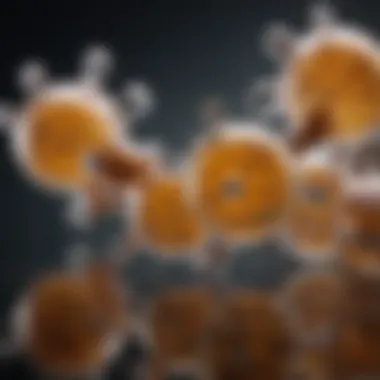Tonic Water: A Potential Remedy for Muscle Cramps


Intro
Muscle cramps can strike when least expected, whether during exercise, at night, or even while sitting still. The sudden tightening of muscles can be quite discomforting and can disrupt daily activities. Many remedies exist, but tonic water has garnered attention for its traditional use in easing cramps. At the heart of this exploration is quinine, a compound historically extracted from the bark of the cinchona tree, celebrated for its muscle-relaxing properties. This article ventures into the realm of tonic water, evaluating its merits and drawbacks in alleviating muscle cramps.
Through examining key concepts and scientific insights, we aim to clarify whether tonic water truly holds water as an effective remedy in muscle cramp management. Let's break down some crucial terms and concepts that bridge the gap between historical practices and modern understanding.
Intro to Muscle Cramps
Muscle cramps present a significant concern for many individuals, and thus it's crucial to understand exactly what they are and their impact on lifestyle and health. In this article, we aim to shed light on muscle cramps, their causes, and potential remedies, including tonic water's role, to guide readers seeking relief from these uncomfortable episodes.
Defining Muscle Cramps
Muscle cramps refer to sudden and involuntary contractions of one or more muscles. They are often intensely painful, catching individuals off guard and interfering with their regular activities. The most common areas for these cramps to strike are the legs, particularly the calves, and muscles in the feet, thighs, and even the abdomen. Some might describe it as an uncomfortable tightening or squeezing sensation, where even a twitch can lead to excruciating pain.
Common Causes of Muscle Cramps
The reasons for muscle cramps can vary widely. Here are several common factors:
- Overuse: Engaging in intense physical activity without proper warm-up may lead to muscle fatigue and cramping.
- Dehydration: Lack of fluids can disturb electrolyte balance, whose implications are often felt during strenuous exercises.
- Nutritional Deficiencies: Inadequate intake of electrolytes—like potassium, sodium, or magnesium—can increase the likelihood of cramping.
- Medical Conditions: Certain medical conditions such as diabetes, thyroid disorders, or nerve compression issues may make individuals more susceptible.
Recognizing these underlying causes can be the first step in developing strategies to circumvent cramps.
Impact on Daily Life
Muscle cramps can disrupt daily activities significantly. A sudden cramp can cause someone to abruptly stop mid-action, whether that's running, dancing, or simply walking down the street. They may experience:
- Interrupted Sleep: Nocturnal leg cramps can rob you of precious hours of sleep, leading to fatigue.
- Reduced Mobility: When muscles tighten unexpectedly, it creates a barrier to movement, making it challenging to engage in everyday tasks.
- Mental Anxiety: The fear of recurring cramps can cause stress and anxiety, particularly in athletes or active individuals. This form of anxiety can further inhibit performance or enjoyment in physical activities.
In essence, muscle cramps are more than just a nuisance; they can significantly alter a person's lifestyle and overall well-being. Understanding their causes and effects is pivotal for individuals looking for remedies, which leads us toward exploring tonic water and its potential as a viable solution.
Tonic Water and Its Constituents
Understanding tonic water and its constituents is essential in evaluating its role in alleviating muscle cramps. The drink's primary ingredient, quinine, offers a historical backdrop and a contemporary view on its efficacy against muscle-related discomfort. Additionally, tonic water comprises other elements, each contributing uniquely to its overall effects and potential benefits.
Composition of Tonic Water
Tonic water has a distinct composition that sets it apart from other carbonated beverages. Primarily, it consists of water, carbonation, sugar or artificial sweeteners, and the critical ingredient, quinine.
- Water: The base element, providing hydration.
- Carbonation: Adds effervescence, which might help in stimulating digestion.
- Sweeteners: Serve to counterbalance the bitterness of quinine, enhancing palatability.
- Quinine: The star of the show; obtained from the bark of the cinchona tree.
This unique blend not only tantalizes the taste buds but also offers potential health benefits, especially when it comes to muscle cramps, which can disrupt daily activities.
The Role of Quinine
Quinine is a bitter alkaloid and the principal medicinal compound found in tonic water. Its significance lies in its muscle-relaxing and pain-relieving properties, making it particularly relevant for those who experience muscle cramps.
- Muscle Relaxation: Quinine works at a molecular level to block specific nerve impulses that trigger muscle contractions. This action can lead to a reduction in cramping symptoms, providing relief for those affected.
- Anti-inflammatory Effects: Additionally, some studies suggest that quinine has anti-inflammatory properties, further supporting its role in managing muscle pain and cramps.
Yet, while quinine has benefits, it is not without its complications. Too much can indeed lead to side effects, making dosage a crucial consideration.


Historical Uses of Quinine
Historically, quinine has fascinating roots as an antidote for ailments much different from muscle cramps. Initially extracted from the cinchona tree, it was once a savior for those suffering from malaria and other fevers.
- Anti-Malaria Treatment: In the 19th century, quinine became widely used to combat malaria, especially in tropical regions. Soldiers and explorers would carry it to ward off the disease, leading to its discovery in tonic water.
- Cultural Significance: The use of quinine in tonic water solidified the drink as a fashionable refreshment among British colonists in places where malaria was prevalent. It was common to mix it with gin, resulting in a pleasurable drink with medicinal properties.
As one can see, quinine’s journey from a jungle discovery to a bar staple mirrors the evolving understanding of its benefits, including its potential role in treating muscle cramps today.
"Quinine’s historical significance in medicine lays the foundation for understanding its contemporary uses and potential benefits in muscle treatment."
In summation, tonic water and its constituents deserve scrutiny when considering remedies for muscle cramps. Understanding the ingredients and their functions may help individuals make more informed choices regarding relief options.
The Mechanism of Quinine
Understanding the mechanism of quinine is key to evaluating its role in muscle cramps. Quinine, a compound found in tonic water, interacts with the body in ways that might alleviate uncomfortable muscle contractions. The importance of this topic extends beyond just the function of quinine; it also encompasses how it fits into a broader context of treatment options for muscle cramps. Its historic use provides a backdrop for modern research that aids in evaluating its role as a remedy.
How Quinine Affects Muscles
Quinine primarily functions as a muscle relaxant. It is believed to work by blocking certain signals in the nervous system that contribute to muscle contraction. Specifically, it interferes with calcium channels in muscle cells. In simpler terms, quinine may help in preventing muscles from cramping by modulating how ions are exchanged across cell membranes.
Additionally, quinine can reduce the excitability of the nerves stimulating the muscles. This is particularly relevant for those experiencing nocturnal leg cramps or cramps during physical activity. The muscle fibers are less likely to overreact and tense up, which could lead to discomfort.
To summarize, some of the effects of quinine on the muscles include:
- Inhibition of calcium uptake, leading to reduced cramping.
- Decreased nerve excitability surrounding muscle tissue.
- Enhanced muscle relaxation following physical stress.
Quinine's muscle-relaxing properties have been part of traditional remedies for ages, but scientific studies continue to examine its efficacy.
Research on Quinine's Efficacy
Research surrounding quinine's effectiveness as a treatment for muscle cramps has produced varied results. Some studies support its benefits while others raise eyebrows about its long-term use. For example, a number of clinical trials have highlighted that quinine can significantly reduce the frequency and intensity of muscle cramps, especially in individuals with specific medical conditions like multiple sclerosis.
However, the use of quinine is not without its critiques. Some scholars point out that the overall effectiveness can vary greatly from person to person. What works like a charm for one individual might not yield the same results for another. Furthermore, potential side effects must be considered, which leads to the ongoing discussion of whether the benefits outweigh the risks. Studies have highlighted:
- Significant reduction in muscle cramps in participants treated with quinine over placebo.
- Reports of serious side effects, including tinnitus and allergic reactions, prompting regulatory caution.
It’s evident that while quinine may offer solutions, understanding its bio-mechanistic effects and the spectrum of research helps in forming a rounded opinion on its usage for alleviating muscle cramps.
Tonic Water: Benefits for Muscle Cramps
Tonic water has attracted attention as a potential remedy for muscle cramps, primarily due to its key ingredient, quinine. This section delves into the intricacies of how tonic water may offer relief, examining anecdotal accounts, scientific findings, and how its efficacy compares with other treatments. Clarifying these elements is crucial for those seeking viable solutions to muscle cramps, as understanding both the inflammatory and physiological effects can shed light on the debate around its usage.
Anecdotal Evidence
Many individuals have shared personal testimonies regarding the impact of tonic water on their muscle cramping episodes. These stories often relay a common thread—people experiencing significant relief after consuming tonic water. For instance, athletes report reaching for tonic water during long-distance events, claiming a reduction in cramps, especially when cranked up with electrolytes or served chilled.
Several users note that mixing tonic water with a slice of lemon boosts its refreshing nature. This utilizes the natural sugars and flavors, making it more palatable. Moreover, there are accounts from patients recovering from certain medical conditions who find that tonic water aids in lessening those pesky cramps, indicating that there may be something to these claims.
However, it's essential to recognize that anecdotal evidence, while valuable, is subjective and varies significantly among individuals. Such stories should ideally be complemented with empirical studies for a more grounded understanding.


Scientific Studies on Tonic Water
Several scientific investigations have explored the effects of tonic water on muscle cramps, often focusing on the action of quinine. Quinine has been recognized for its muscle-relaxing properties, providing a more systematic approach when examining its capabilities. Notably, some studies suggest that quinine may alter neuromuscular transmission, which could reduce the frequency of cramps.
In a notable randomized controlled trial, subjects who received quinine reported a distinct decrease in nocturnal leg cramps compared to those who received a placebo. Test subjects consuming tonic water containing quinine documented fewer episodes of muscle cramps over a span of weeks compared to those not consuming it. While these studies offer insightful data, they often utilize dosages higher than what one would typically get from tonic water consumed casually.
Concerns have arisen regarding the potential side effects at higher doses, which often leads to calls for caution. Thus, while findings are promising, they pave the way for more extensive research to confirm safety and efficacy.
Comparison with Other Remedies
When evaluating tonic water against other traditional remedies for muscle cramps, a multifaceted picture emerges. Many consider hydration as a fundamental remedy, often emphasizing electrolyte beverages that replenish sodium, potassium, and magnesium. These drinks, like Gatorade or coconut water, are widely touted for their cramp-relieving abilities.
In contrast, while tonic water can provide relief due to quinine, its effectiveness may not surpass that of specific electrolyte drinks. Additionally, alternative remedies like stretching exercises and topical treatments using capsaicin or menthol are frequently recommended. The choice between these options often boils down to personal preferences and individual responses to these treatments.
In terms of availability, tonic water can be found in most grocery stores, making it an accessible choice, whereas some other remedies may require specific brands or formulations. Despite this convenience, users should weigh the merits and drawbacks of each option based on their individual experiences and health conditions.
Potential Risks and Side Effects
Understanding the potential risks and side effects associated with tonic water is crucial for anyone considering its use as a remedy for muscle cramps. While tonic water can offer certain benefits, it is not without its drawbacks. Knowledge in this area helps individuals make informed decisions regarding their health. This section delves into the specific adverse reactions and interactions with medications that may arise from tonic water consumption.
Possible Adverse Reactions
Tonic water is primarily composed of carbonated water, sugar, and quinine. Quinine, though traditionally valued for its properties, may provoke some unwanted effects in certain individuals. Possible adverse reactions to tonic water range from minor troubles to more significant health concerns.
- Digestive issues: Some people might experience nausea or an upset stomach after consuming tonic water. This could be due to its carbonation or the sweetness of the drink.
- Allergic reactions: In rare cases, an individual might have an allergy to quinine itself or any other components in the tonic water. Symptoms can include rash, hives, or even difficulty breathing.
- Neurological effects: High doses of quinine are known to cause serious side effects like tinnitus or disturbances in vision. While tonic water contains quinine at much lower levels, it's essential to pay attention to any unusual symptoms after consumption.
The true extent of these reactions varies widely among individuals, making it vital for consumers to gauge their own body's response carefully.
Interactions with Medications
Another significant aspect to consider when evaluating tonic water is its potential interactions with various medications. Many people may overlook how their treatments can be affected by what they drink.
Here are some critical interactions to watch out for:
- Antimalarials: Quinine has been used in treating malaria. If one is on medication for this condition, consuming more quinine through tonic water could lead to excessive levels in the bloodstream, increasing the risk of adverse effects.
- Blood thinners: Tonic water could potentially increase the effects of blood-thinning medications like warfarin. Higher levels of quinine may enhance the anticoagulant properties, which could lead to complications.
- Certain heart medications: Quinine might influence the effectiveness and metabolism of various cardiac drugs, which could complicate treatment regimens.
It is essential for anyone on medication to consult with a healthcare professional before incorporating tonic water into their diet. Each person's medical history and current prescriptions can greatly influence how their body reacts to the quinine in tonic water.
"A little knowledge can be a dangerous thing; knowing how tonic water might interact with medications can be crucial for your health."
Considerations for Use
When pondering the role of tonic water as a means to alleviate muscle cramps, it's paramount to consider not just its potential benefits but also the circumstances under which its use may not be advisable. The diverse population—we all have unique health backgrounds and varying lifestyles—impacts how a remedy works for an individual. This section underscores several important elements that can guide someone deciding whether to incorporate tonic water into their regimen.
Who Should Avoid Tonic Water
While tonic water might seem like a feasible option for easing muscle cramps, certain individuals are better off steering clear. Here are important groups to consider:
- Pregnant or Nursing Women: The safety of quinine, tonic water’s main active ingredient, during pregnancy and lactation needs caution. Though the risks are still debated, many experts suggest avoiding it altogether to be on the safe side.
- Individuals with Liver Conditions: People suffering from liver diseases, such as cirrhosis or hepatitis, should be wary. Quinine may exacerbate existing problems due to its metabolism in the liver.
- Those with Allergies to Quinine: Some folks have experienced adverse reactions to quinine, leading to allergies. If there's a known sensitivity, tonic water should definitely be off the table.
- People on Certain Medications: It’s crucial for individuals undergoing treatment with anticoagulants or other drugs that may interact adversely with quinine to consult with a healthcare professional before consuming tonic water.
- Athletes in High-Performance Zones: In this case, the consumption of tonic water might not provide the expected performance benefits and could introduce possible risks. Athletes often rely on precise hydration strategies that tonic water might not fit into nicely.


Recommended Dosage and Consumption
For those who find themselves within the green light for tonic water use, understanding the right dosage and consumption method is vital. Moderation is key—and people often need to find a balance that works for their unique bodies.
- Typical Serving Size: A moderate approach would be about 4-6 ounces of tonic water, mixed with a healthy dose of caution regarding frequency. It's advisable not to exceed these amounts regularly.
- Time of Consumption: For muscle cramps, consuming tonic water after physical activity or in times when cramping is anticipated could potentially maximize its benefits.
- Better with Moderation: Drinking tonic water daily isn't necessarily better. Occasionally incorporating it—perhaps a few times a week—may prevent any potential negative side effects associated with over-consumption.
Tonic water can be a simple addition to your routine, but it's best to view it as a complement to a rounded diet and other recovery practices.
"In life, one must weigh the pros and cons carefully, especially when it comes to health-related decisions."
Above all, the emphasis is on listening to one’s body and consulting with medical professionals when uncertain. It allows for a more tailored approach to managing muscle cramps while considering one’s personal health narrative.
Alternative Remedies for Muscle Cramps
When it comes to addressing muscle cramps, tonic water with its quinine content is one option, but it’s crucial to take a step back and evaluate other potential remedies. This broadens the conversation around muscle cramps and promotes a deeper understanding of various alleviation strategies. Recognizing alternative remedies helps in developing a comprehensive approach tailored to individual needs and preferences. Every option of relief—be it stretching, hydration, electrolyte replenishment, or topical treatments—has its distinct benefits and challenges. Thus, it's important to discuss these alternatives thoroughly.
Stretching and Hydration
Stretching often gets a bad rap among those seeking quick relief from those pesky cramps. When muscles feel tight or knotted, gently stretching the area can provide immediate comfort, restoring flexibility and blood flow. For example, a simple calf stretch can be effective for cramps in that region. Holding the stretch for about 15-30 seconds can sometimes do the trick.
Hydration, however, goes hand-in-hand with stretching. When the body is deprived of adequate fluids, muscles can spasm and cramp. Water plays a vital role in maintaining the health of muscle tissues, thus reinforcing how critical hydration is for those who encounter frequent cramps. It's essential to keep a water bottle handy during physical activities.
Electrolyte Replenishment
Electrolytes are the unsung heroes of muscle function. These minerals, including sodium, potassium, magnesium, and calcium, help to maintain fluid balance and nerve conduction. Often, muscle cramps may signal an imbalance in these essential minerals.
Consuming sports drinks or electrolyte supplements can assist in reclaiming that balance after intense exercise. Of course, fresh fruit like bananas or avocados provides a more whole-food approach to replace lost potassium. Keep in mind that while proactive replenishment can stave off cramps, going overboard with supplements can have unwanted consequences. Balance is key in this regard.
Topical Treatments
Topical treatments represent another interesting layer in the pursuit of cramp relief. Creams and ointments that contain muscle-soothing ingredients—like menthol or capsaicin—can be applied to the affected areas. These substances work by creating a warming or cooling sensation that often distracts from the sensation of cramping.
Furthermore, some individuals may choose to explore options like acupuncture or massage, both of which can also play a role in alleviating tension in muscles.
"It’s essential to approach muscle cramp management from multiple angles; integrating stretching, hydration, electrolytes, and topical treatments can yield better results."
Finales
The exploration of tonic water's potential role in alleviating muscle cramps unfolds a fascinating dialogue about remedies and their varying degrees of effectiveness. Understanding how tonic water, largely thanks to its quinine content, may ease those bothersome cramping episodes is essential for those who frequently encounter such discomfort. The merits of this fizzy drink, while intriguing, also raise important considerations regarding its overall effectiveness and safety for different individuals.
Summary of Findings
In this article, we delved into several crucial aspects regarding the relationship between tonic water and muscle cramps. Here are some key points:
- Composition and Role of Quinine: Tonic water's primary ingredient, quinine, has a storied background in treating muscle cramps and was originally employed for its medicinal properties. Its efficacy, however, sees a variety of opinions in modern discourse.
- Anecdotal vs. Scientific Evidence: There’s a wealth of personal anecdotes extolling the virtues of tonic water for muscle cramps; yet, scientific studies present a more nuanced picture, often highlighting the need for further research to substantiate anecdotal claims.
- Comparison with Other Remedies: It's been established that while tonic water holds potential benefits, it is not the sole option on the market. Many like hydrating properly, stretching exercises, or electrolyte-replenishing drinks can also provide relief.
- Potential Risks and Considerations: The possible side effects of tonic water, especially concerning individuals on certain medications or with specific health conditions, should be carefully considered before use.
Overall, while tonic water may serve as a helpful remedy for some, it’s not a one-size-fits-all solution, and caution should be exercised, especially among sensitive populations.
Final Thoughts on Tonic Water
When evaluating tonic water as a remedy for muscle cramps, it is vital to appreciate both its historical context and current scientific perspective. Tonic water brings a sense of nostalgia combined with modern practicality, yet its effectiveness isn’t universally agreed upon.
In addition to potential benefits, including its refreshing taste, users must weigh the drawbacks and individual circumstances before integrating it into their regimen. It is paramount to view tonic water not merely as a quick fix, but rather as a part of a broader strategy for managing muscle cramps that may involve more holistic approaches, such as lifestyle adjustments and proper hydration.
"Tonic water can be a light at the end of the cramp-filled tunnel, but like all things, it's essential to approach with both enthusiasm and caution."
Thus, as we reflect on the role of tonic water, remember that knowledge and discernment guide the journey to effective cramp management.







